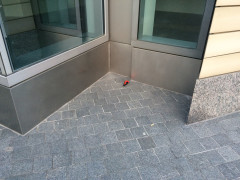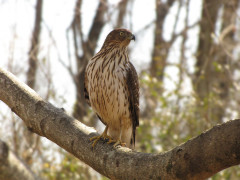Although migratory birds usually garner all the attention, many beautiful birds can be found in our area all winter long. In fact, winter is one of the best times to enjoy your local bird life. With most of the leaves off the trees, visibility is often better and many brightly colored birds such as Northern Cardinals and Blue Jays are easy to spot [Read More …]
Pigeons: Misunderstood But Magnificent!
It is easy to overlook a pigeon. For some people, they are a common and unwanted sight, crowding streets, public squares and parks, and roosting on rooftops. Their ability to thrive in urban environments has earned them “pest status.” Interestingly, this ability to adapt and thrive in a variety of situations is also the very quality that has led [Read More …]
Ben’s Bird: the Wonderful World of Wild Turkeys
Most of us have strong associations with turkeys even if Thanksgiving dinner was not part of our family’s traditional celebration. We learn to identify them at an early age, often by making turkey cutouts for handcrafted Thanksgiving cards, hearing stories about the first Thanksgiving, and learning of Benjamin Franklin's famed appreciation for the [Read More …]
Walking With Lights Out DC
A Volunteer's Perspective by Stephanie P. Dalke I am not a morning person—at ALL. But I love birds and know that building strikes are a major but poorly understood problem, so last spring I finally took the step to volunteer for the Lights Out program. During peak migration each spring and fall, volunteers monitor routes downtown to find birds [Read More …]
Woodpeckers of Washington D.C.
Known for their long beaks, distinctive drumming, and hard heads, woodpeckers are one of the most common forest birds sighted in Rock Creek Park. They serve an important ecological role in both the creation of cavity nests and the decomposition of dead trees. Their thick skulls, strong beaks, and powerful neck muscles allow them to deliver sharp [Read More …]
Special Fundraising Event on October 27th!
This year Teddy and the Bully Bar will be giving a portion of the proceeds of their celebratory event honoring Teddy Roosevelt to City Wildlife. Please join us for this special fundraising event to honor this beloved American president and support City Wildlife. We hope to see you there! [Read More …]
Hovering with Hummingbirds
Unless you are near a flowering garden or a nectar feeder, you will likely have a hard time catching sight of a hummingbird. Most hummingbirds zip around at high speeds, weaving skillfully through plants and going from garden to garden in search of their next meal. Able to maneuver around obstacles with deft precision, hummingbirds can come to a [Read More …]
Raptors In Our City
Catching sight of a Cooper’s Hawk is usually just a matter of being attentive. Until a few decades ago, they were considered relatively rare in urban and suburban areas. Today, Cooper’s Hawks are notorious for stalking bird feeders where they can pick off unsuspecting birds for an easy meal. Some studies show that their numbers are actually higher [Read More …]
When to Intervene
On a typical day at City Wildlife, depending on the season and the weather, we take in anywhere from zero to fifteen or more animals. About half of them are brought in by concerned citizens. The other half are brought in by one of the District’s Animal Care and Control Officers (ACOs). On any given day, ACOs respond to multiple calls which can [Read More …]
Odyssey of an Urban Box Turtle
Whether it was in the wild or in captivity, most of us have seen a box turtle at least once in our lives. At the time, we may not have given this small reptile much consideration. They move slowly, lumbering along on their short legs and seldom seem interested in interacting with the curious humans who cross their path. They generally retreat at [Read More …]
- « Previous Page
- 1
- …
- 6
- 7
- 8
- 9
- Next Page »











